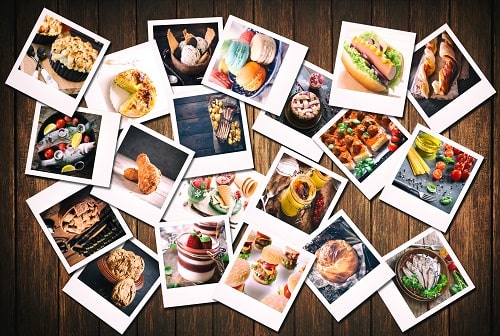I love food. I love to cook food; I love to buy food; I love to eat food. I love to read about food and learn about new foods. I am a rabid fan of the Food Network. I love to feed people and watch others eat food. I plan my meals carefully and well in advance. I exercise so I can eat more food.
I think I come by this obsession naturally: my grandparents’ last name meant “Hearty Eaters.” Family celebrations centered around food. Church functions always included something to eat. I would race home from school to my grandmother’s house, and we would cook together. I have a repertoire of family recipes that bring me joy to cook and to pass down to my own children.
But to be very honest, my experience with food for the first 22 years of my life was limited. I ate simple American food, unless we wanted something special and then we might eat Chinese food, or at least the American equivalent. Mexican food consisted of Taco Bell. Italian food meant Ragu spaghetti sauce. We did not shop in the ethnic foods section of the supermarket, nor did we frequent any of the more exotic restaurants that sold food that was unfamiliar.
When my husband and I decided to move overseas for several years, one of my first thoughts was, “What are we going to eat?” I was unfamiliar with the cuisine of that culture and wondered if we could survive on grilled cheese sandwiches. We had enough granola bars to last us a while, but eventually those would run out.
As we settled into our new culture, however, our fear of the unknown local foods dissipated. It was a slow process, but one that we moved through intentionally. We loved the culture to which we had moved, so we knew it would be important for us to love the food as well, especially since a passion for food was a part of who we were.
Reflecting on that time, there were a few key things that helped us turn the corner. I can still remember the day when we found ourselves craving a previously unfamiliar fare. It didn’t happen without effort, but it did happen. And it can happen for you, too.
Realize food is a key to cultural understanding. The goal of any overseas worker is to work through culture shock and cultural adaptation to increasing levels of cultural understanding. In most Global South cultures, their food is an important part of their identity. Food takes a long time to prepare and ingredients are hard to come by. They use the freshest of produce and loathe leftovers. They take their time eating meals and rarely waste food. They love to feed others: it’s a sign of their expert hospitality and their innate spirit of generosity. Even in the most impoverished of families, they give their guests and their family members as much food and drink as they are able. What makes them do these things? Why is the act of eating so crucial to who they are? What makes these unfamiliar-to-us dishes so dear to them? Asking questions that take a deep dive into their culture of food will reveal so much about the people themselves and will build bridges of relationship that will be meaningful. Eating these new foods in the presence of these new friends will creating a lasting bond in the earliest days of your cultural adventure. Yes, we might be fearful we won’t like certain foods, but if something is so important to others, isn’t it worth the risk of exercising our taste buds with something different? Our dedication to cultural understanding will be the first step in appreciating global cooking.
Learn about the ingredients. Many people are fearful of ethnic cuisine simply because they don’t know what it is. I remember being introduced to Indian food for the first time. All I knew about it was that some people reported having tummy troubles after eating it. I didn’t know if that was true or what that even meant. So I avoided Indian food at all costs. However, after spending some time in India, I began to learn about the recipes of the most popular dishes. I learned about the ingredients that went in to these gorgeous creations. And, to my surprise, the ingredients were all familiar to me! In fact, they were nearly the same ingredients that went into my beloved Mexican food, just in different proportions and with a little extra chili pepper thrown in for good measure. Once I knew what I was eating, it was much easier for me to welcome these foods into my diet. In the same way, if there was an ingredient I knew would not agree with my stomach, I could avoid that particular ingredient without discarding the entire menu of rich, historical foods.
Cook together with the nationals. I can remember the first time I sat on an old knotted log around an open fire covered by an immense steel frying pan, rolling flat bread and cooking them dozens at a time. Those flat breads instantly became my new favorite food. One of my greatest joys was spending time with national women in their kitchens learning how to cook the local cuisine. I thoroughly enjoyed the informal cooking lessons they gave as they showed me their own method of making popular everyday foods for their families. Rarely did they measure any ingredient. Even less frequently did they know exactly how long something was supposed to cook. Everything was done as a result of their decades of experience in the kitchen. I scribbled down as many notes as I could, and slowly tried my own hand at those same dishes. I never truly mastered the art of this delicious cooking, but whenever I had a chance to eat their cooking, I devoured it. No longer did I wonder how I might be able to finish my whole serving of whatever they had generously offered me. Spending time with these women in the kitchen changed my perspective and gave me the appetite for new foods that I never thought I’d have.
Be brave. If all else fails, for the sake of building relationships and maturing in our own adulthood, simply be brave. If you don’t know what a food is, but someone offers it lovingly to you, go for it. If someone offers you a cup of some hot beverage in a questionably clean cup, drink it anyway. Foods prepared with love are the richest sources of nutrition with which we can bless our bodies. Take a risk. Eat that unfamiliar meat. Throw caution to the wind. Slurp up that chunky soup. The adventure you’re on requires sacrifice. That sacrifice may just lead you to a new love and passion you never expected to find. Yes, I love food. But I love people more. My love for people deepened the more I accepted them and accepted their f




